As part of the emergency active travel funding, the cycle tracks on Magdalen Bridge have been widened. On Wednesday evening (August 5) I went and had a look at the changes for myself. There I ran into Chris (Pedal&Post) and we watched the interactions between motor traffic and people cycling for maybe half an hour, from 5.30 to 6pm.
What are the changes? The cycle lanes on the bridge — and a short distance on either side — have been widened, maybe from 1.5m to 2.2m (the plans show 2.4m, but it appears that was reduced in the implementation). And the centre line has been removed. There are also large cycle symbols in each of the cycle lanes.
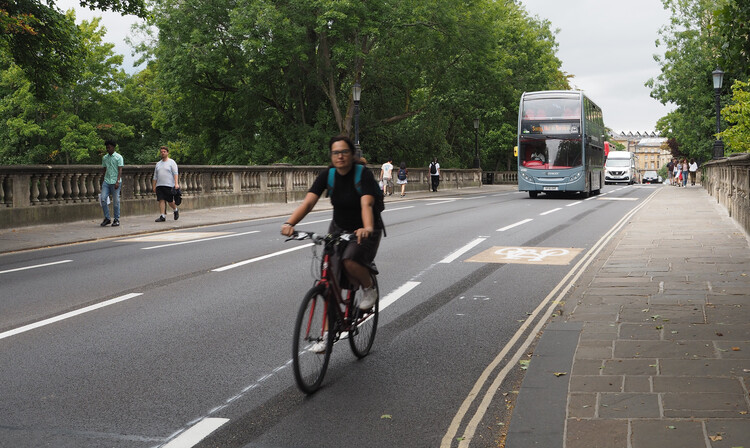
Here's the plan (thanks Graham Smith):
How does it work? Traffic speeds seemed to be lower than before, but that's hard to judge (and may be a temporary effect due to the unfamiliarity of the layout). And it looks more inviting for people cycling — I could just about imagine cycling here with my seven year-old now, getting her to keep left and holding the outside of the lane behind her.
The new configuration may be marginally better for people walking, as there seemed to be fewer people cycling right on the kerbline.
The major concern is that, with the central carriageway just 4.6m wide at narrowest (from the plan), two buses are unable to pass one another without entering the cycle lanes. For two cars this is possible, if only just for large SUVs, though drivers may be tempted to swerve into the cycle track to increase their separation from oncoming vehicles, rather than slowing down. But two buses can not physically pass one another without entering the cycle lanes, which poses a real problem if they meet each other when those lanes are full (with cycles overtaking one another, or simply with peak-hour two bicycle wide densities).
There are about 10,000 motor vehicles a day here at the moment, and historical counts suggest 14,000 a day (see below).
Something like this approach has also been implemented on Windmill Rd, and something similar is planned for Abingdon Rd. The key there is likely to be continuous provision.
Uncertainties
Since the changes have just gone in, people are mostly encountering the new layout for the first time and their behaviour may change once they are accustomed to the layout. Most likely they will become less cautious and drive faster.
Traffic is still not back to pre-lockdown levels and it is August, without most undergraduates but with nothing like normal tourist numbers. So both cycle and car and pedestrian numbers are significantly lower than potential peaks. The Oxbike counts for the 24 hours to 8.30pm that day were 7,600 cars; 4,500 cycles; 4,100 pedestrians; and 2,500 buses - but the last (2018) historical DfT traffic counts/estimates were 12,000 cars/vans, 12,000 cycles, and 2,100 buses.
I saw one "snapshot" with relatively dense traffic. The dynamics will be very different at low traffic levels. If there's no traffic going the other way, many drivers are likely to do 30mph here (as they currently do) and some may drive faster with the missing central line removing the "constraint" of a narrow traffic lane. When faced with oncoming traffic, some of these drivers are likely to use the cycle lane rather than slow down. But the wider cycle lanes may increase the passing distances to people cycling.
There's a risk of "observer interference". I'm pretty sure at least one bus driver started veering into the cycle lane and changed their mind when they saw Chris obviously videoing them on his smartphone and me pointing a moderately large camera at them.
I've also had at least three other people tell me they feel much safer cycling with children here, so there seems to have been an improvement in subjective safety.
The Broader Context
There have been no changes on either side of the bridge, either to the Plain roundabout or to the horrible bit of High St between Magdalen College and the Botanic Gardens. The westbound cycle lane there just disappears, and people cycling to Longwall have to cross a lane of motor traffic and then filter between traffic lanes, while the eastbound lane is dangerously narrow (worse than Magdalen Bridge itself was before the current changes).
So, however it works out, this change isn't by itself going to do much to enable more people to cycle. We really need that bus gate on St Cross or South Parks, to reduce motor traffic enough that the right-hand turn lane at Longwall can be removed, freeing up space there for adequate cycle lanes, and so the Magdalen Bridge entry to the Plain can be narrowed to a single lane, allowing reconfiguration of the roundabout along Dutch lines (as has been done in locations in Cambridge and Manchester).

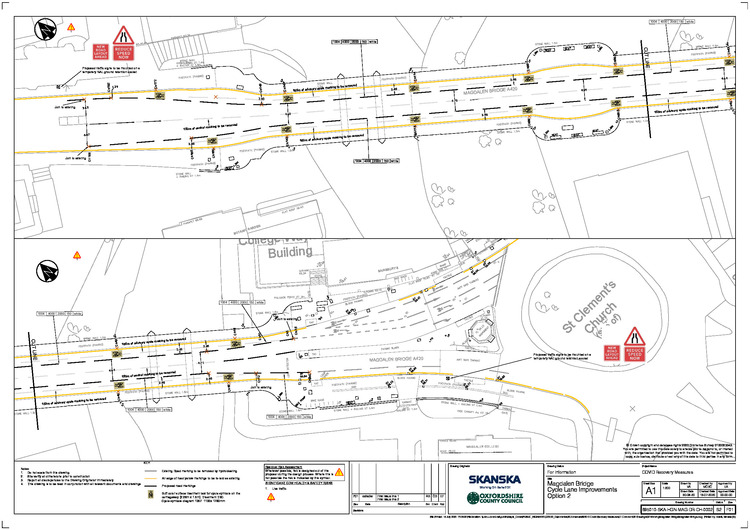
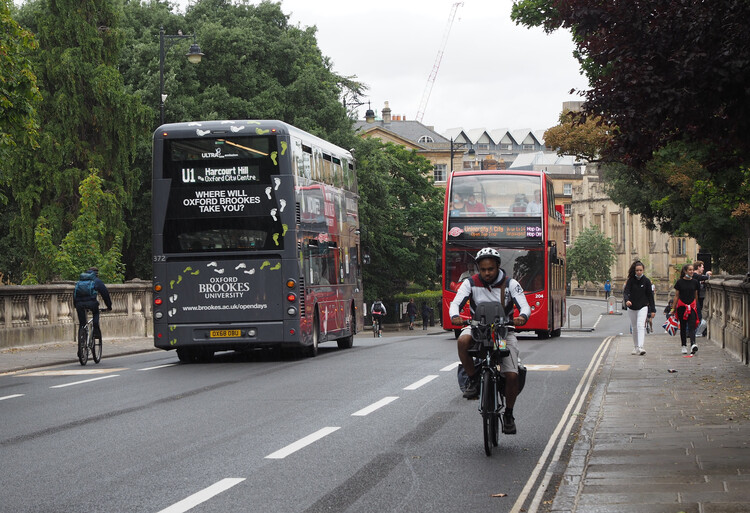
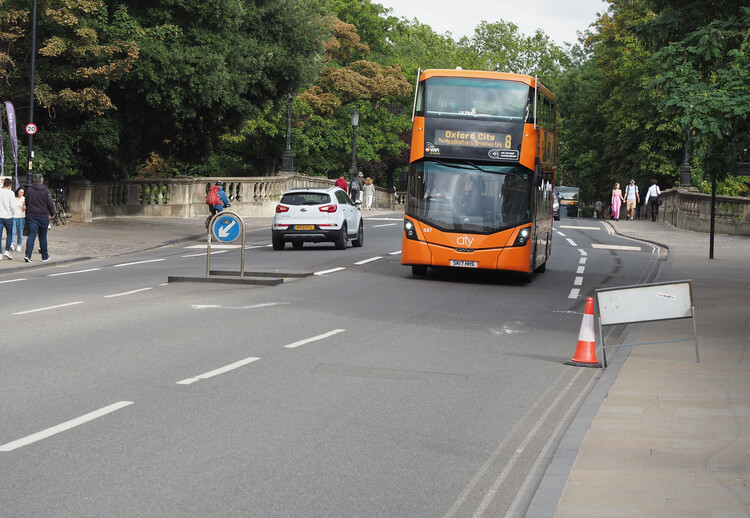
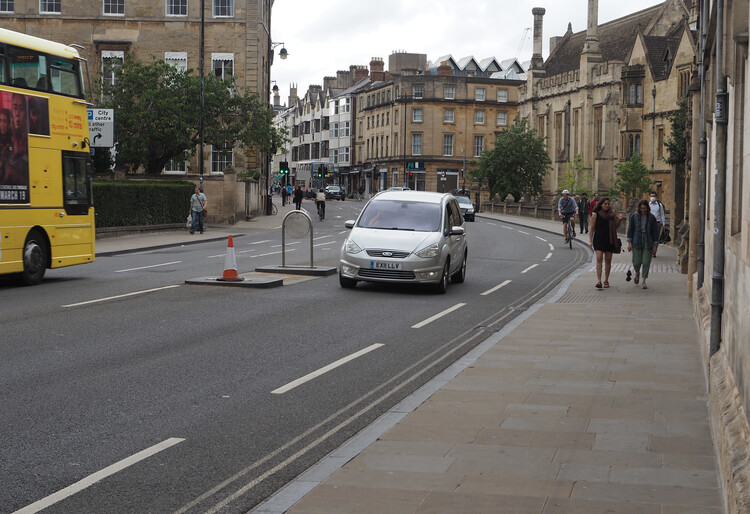
It is a really tricky area. I think the setup will work providing that buses never overtake cyclists except by giving them a lot of room. It might even be appropriate to legislate that buses may never overtake cyclists at any point - it isn't a long stretch of road.
I am struggling to think of a better way to manage the road, short of banning all motor vehicles, which isn't practical.
Dan, even if buses never overtake bicycles, what happens in my hypothetical situation where two buses meet each other when they both have full cycle lanes (due to overtaking or just cycle congestion/bunching) next to them?
I've seen really harsh / raised road studs put in the road in Las Palmas. They're really (really) unpleasant for cars to drive over, but you can temporarily cross over them without damaging the vehicle. (for example to allow buses passing). This might work, where large physical barriers can't be installed between buses and bikes - but you need to stop most motorists routinely crossing into the bike lane.
Is this the kind of thing you are thinking of, Richard? https://www.cyclehoop.com/wp-content/uploads/2014/04/Salford-Armadillos1.jpg These "armadillos" might work nicely here if there were a bit more room. The problem is that the buses have no choice but to cross into the cycle lanes - apart from that being bumpy for the buses, it's also likely to break most armadillo implementations in pretty short order.
The is no point making the road lanes too narrow for buses and trucks. That doesn't increase safety it increases the danger. For example that cyclist, unnecessarily riding out in right hand side of the lane, is about to get side-swiped by mirror is the bus doesn't take illegal evasive action or make them move over with a horn blast.
Cyclist shouldn't be riding abreast on on-road cycle lanes (it's illegal in NSW), that's just asking for wheel or pedal touches and people toppling out into the path of vehicles. The width is to increase separation between cyclists and vehicles and the curb/drains while giving them some safety margin in moving, avoiding pot-holes, glass etc. Cyclist should keep left allowing faster riders to overtake when it is safe. Here that what cyclists will have to do. Though my experience from trying to instruct people on Bike North beginner rides was that cyclists in a cyclelane just ride on paying no attention to what is happening on the road behind them.
Pertinax, the man cycling in the first photo may need to move right to enter the Plain roundabout (which is a problem all of its own). Also, he hasn't actually moved to the right of the lane, so much as the cycle lane has shrunk on him. (Having lanes which unpredictably shrink or expand is a safety issue, here and elsewhere.)
I think cycle lanes need to be designed so that people using them _don't_ have to pay too much attention to what's behind them. And riding two abreast would be a bit anti-social in peak hour, but at other times seems fine if the track/lane is adequate - it's normal practice in the Netherlands.
The Slade yout at the Old Road crossroads is dangerous. The cycle lane across the junction heading north towards Windmill Road has been painted directly in front of the left turn lane, not the lane to go straight ahead. Any cyclist aligning themselves with the painted cycle lane will be blocking the left turn lane traffic during their solo green phase - which lasts quite a long time. This is extremely annoying for motorists and could be dangerous for cyclists if a car driver gets impatient.